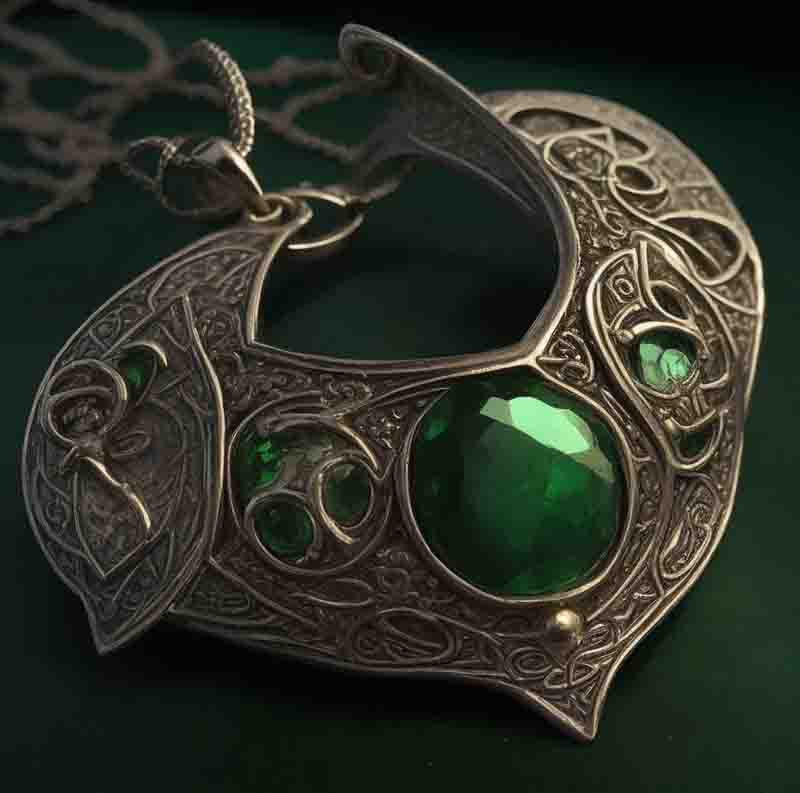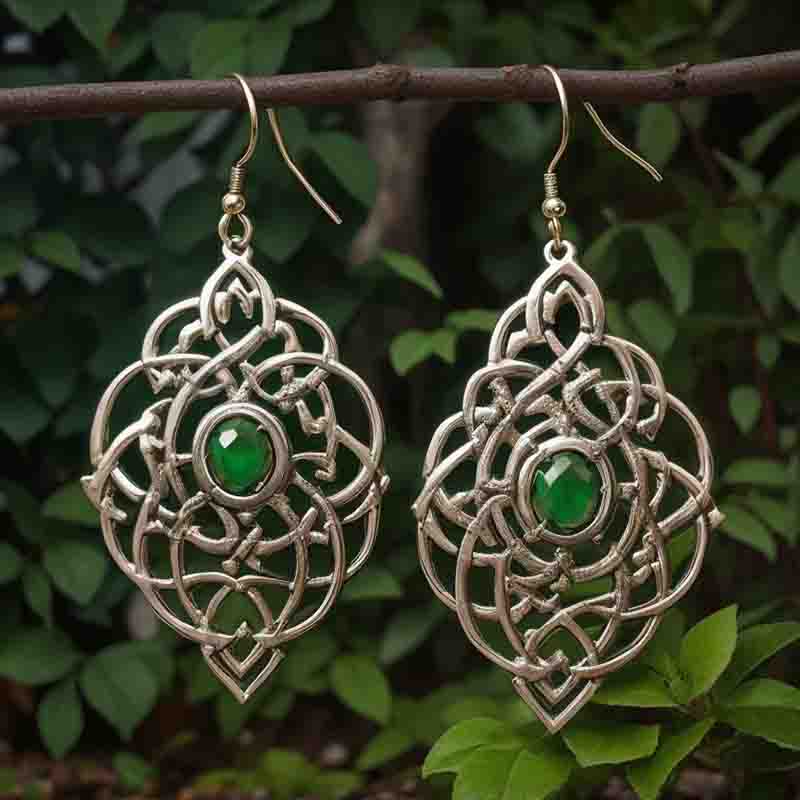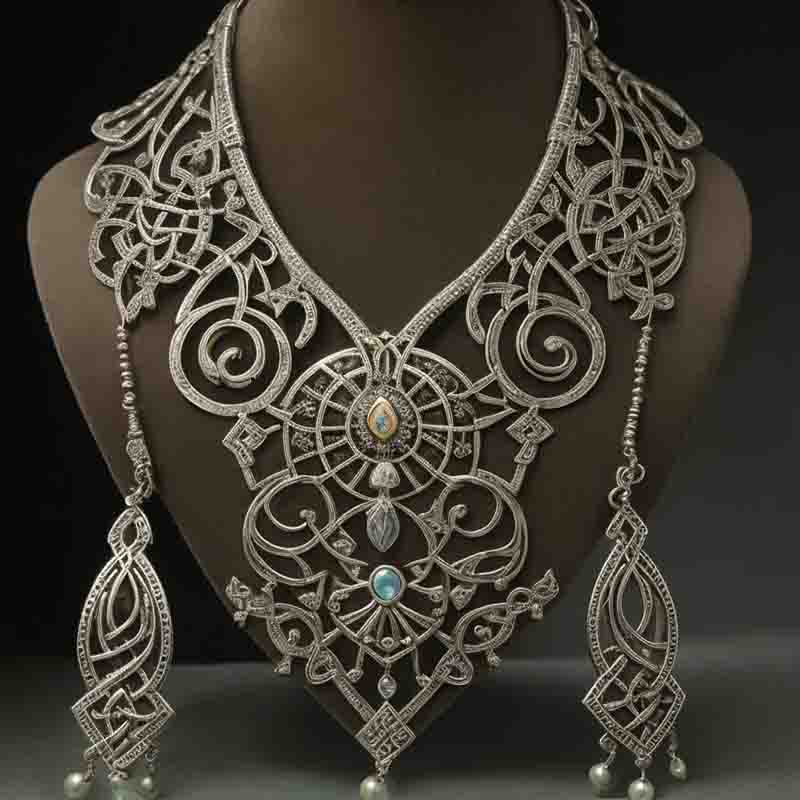Celtic Jewelry: A Treasured Legacy
Celtic jewelry, with its intricate patterns and profound symbolism, has a history deeply rooted in the ancient traditions of the Celtic people. Each piece of Celtic jewelry tell a story, whether it's a pendant depicting the triple spirals of life, death, and rebirth or a silver bracelet adorned with intricate knotwork symbolizing eternity and unity.

With their intricate knots, symbolic motifs, and use of precious metals, Celtic jewelry is not simply ornamentation, but rather vessels charged with history, tradition, and artistry.
The Origins of Celtic Jewelry
Celtic jewelry finds its origins in the art, culture and craftsmanship of the Celtic tribes, which were spread across Europe, particularly in regions we now know as Ireland, Scotland, Wales, and Brittany, among others.
The earliest forms of Celtic jewelry were crafted from materials such as bronze, and these pieces often featured geometric patterns and symbols inspired by nature.
Celtic jewelry is a true reflection of its rich cultural heritage. Steeped in history, craftsmanship, and symbolism, these exquisite pieces of jewelry are not just ornaments; they are storytelling devices.
Celtic Jewelry in the Iron Age
As the Celtic people transitioned into the Iron Age, their jewelry-making techniques became more sophisticated.
Intricate knotwork, spiral designs, and motifs inspired by the natural world, such as animals and plants, began to emerge.
These designs not only adorned the body but also conveyed deeper meanings, representing concepts like eternity, love, and protection.
The Influence of Christianity
With the arrival of Christianity in Celtic regions, new symbols and designs made their way into Celtic jewelry.
The Celtic cross, a fusion of the Christian cross with traditional Celtic knotwork, became a prominent motif, representing the merging of old and new belief systems.
Celtic Jewelry: From its Origins to the Present Day
| # | Time Period | Key Events and Developments in Celtic jewelry |
|---|---|---|
| 1 | Ancient Celtic Civilizations | Celtic tribes craft early Celtic jewelry from materials like bronze. |
| 2 | Celtic Iron Age (circa 500 BC) | Transition to the Iron Age brings increased sophistication in jewelry crafting. |
| 3 | Arrival of Christianity | Introduction of Christianity influences Celtic jewelry design. |
| 4 | Viking and Norse Influence | Viking invasions influence Celtic jewelry with their distinctive styles. |
| 5 | Celtic Revival (19th century) | A renewed interest in Celtic culture leads to a revival of Celtic jewelry. |
| 6 | Modern Era (20th century) | Celtic jewelry becomes popular internationally due to its timeless appeal. |
| 7 | Contemporary Trends (present) | Modern Celtic jewelry incorporates minimalist and fusion styles. |
The Revival of Celtic Jewelry
Celtic jewelry experienced a resurgence in the 19th century during the Celtic Revival, a period marked by a renewed interest in Celtic culture and heritage.
Artisans drew inspiration from ancient Celtic artefacts to create pieces that celebrated the rich history and symbolism of Celtic jewelry.
This revival continues to influence modern Celtic jewelry design.
Celtic Jewelry and Cultural Connection

Dating back over 2,000 years, Celtic jewelry holds a unique place in the world of adornment.
Celtic jewelry is especially popular and often manufactured in various regions with a strong Celtic heritage.
Here's a list of places where Celtic jewelry is known for its popularity and production:
Celtic Jewelry in Ireland
Ireland is widely recognized as one of the foremost hubs for Celtic jewelry.
With a deep-rooted Celtic heritage that spans thousands of years, Ireland boasts a rich tradition of crafting intricate and meaningful Celtic jewelry.
This jewelry often incorporates iconic Celtic symbols, such as the Claddagh ring, Trinity knot, and the Celtic cross, each carrying its own symbolism and significance.
The craftsmanship of Irish jewelers is highly regarded for its attention to detail and the use of traditional techniques, including filigree and hand-engraving.
Many jewelry workshops and artisans are scattered throughout the country, particularly in places like Dublin, Galway, and Belfast.
These artisans draw inspiration from the country's stunning landscapes, mythology, and Celtic history to create timeless pieces that are treasured both in Ireland and around the world.
Celtic Jewelry in Scotland
Scotland, with its strong Celtic heritage, is another prominent center for Celtic jewelry production.
Edinburgh, the capital of Scotland, is a hub for jewelry makers known for crafting exquisite Celtic designs.
The Scottish Highlands, in particular, are renowned for their Celtic jewelry, often featuring motifs like the Scottish thistle, Celtic knots, and Celtic crosses.
These pieces often reflect the rugged beauty of the Scottish landscape and the rich tapestry of Scottish history and legends.
Skilled Scottish artisans take pride in their craftsmanship, and the jewelry they create captures the essence of Scotland's Celtic heritage, making it a sought-after choice for those who appreciate the beauty and symbolism of Celtic jewelry.
Celtic Jewelry in Wales
Wales, like its Celtic counterparts, has a unique and distinctive Celtic heritage.
Welsh Celtic jewelry is inspired by the country's rich history and cultural traditions.
Jewelry from Wales often features elements such as the iconic Welsh dragon, the Daffodil, and the leek, along with Celtic knotwork and designs.
These symbols are not only aesthetically pleasing but also hold deep cultural and historical significance.
Welsh jewelers, often based in cities like Cardiff and Swansea, use their craft to celebrate Wales's Celtic heritage and create pieces that are cherished by both locals and enthusiasts worldwide.
Celtic Jewelry in Cornwall, England
Cornwall, located in the southwest of England, has its own Celtic heritage and traditions.
Celtic jewelry in Cornwall often combines elements of Cornish culture with classic Celtic designs.
Symbols like the Cornish Chough, St. Piran's flag, and Celtic knots are prevalent in the jewelry produced here.
Cornwall's Celtic jewelry reflects its unique cultural blend and is often crafted by skilled artisans who take pride in preserving and celebrating the region's Celtic roots.
Celtic Jewelry in Brittany, France
Brittany, a region in northwestern France, has a strong Celtic connection dating back to ancient times.
Celtic jewelry in Brittany is heavily influenced by Breton culture and Celtic symbolism.
Designs often feature elements like the ermine, Breton crosses, and the triskelion, along with traditional Celtic motifs.
The artisans in Brittany draw inspiration from the region's history, legends, and Celtic heritage to create unique and meaningful pieces of jewelry.
Brittany's Celtic jewelry showcases a fusion of French and Celtic influences, making it a special choice for those seeking jewelry with a Breton flair.
Celtic Jewelry in Galicia, Spain
Galicia, in the northwest of Spain, has its own Celtic roots, and this influence is reflected in the Celtic jewelry crafted here.
Celtic designs in Galicia often incorporate symbols like the Gallaecian bridle, the Galician bagpipe, and Celtic knotwork.
The jewelry makers in this region pay homage to the Celtic legacy of Galicia, creating pieces that resonate with the cultural and historical heritage of the area.
Galician Celtic jewelry is a testament to the enduring influence of Celtic traditions in unexpected corners of the world.
Celtic Jewelry on the Isle of Man
The Isle of Man, located in the Irish Sea, has a unique Celtic heritage and is known for its distinctive Celtic jewelry.
The Manx Knot, a variation of the Celtic knot, is a prevalent design element in Manx jewelry.
The craftsmanship on the Isle of Man is highly regarded, and artisans take pride in creating intricate and meaningful pieces that showcase the island's Celtic identity.
The Manx Knot, with its interconnectedness and symbolism, is a prominent feature in Manx jewelry, and it is often favored by those seeking jewelry with a strong Manx connection.
Celtic Communities Worldwide

Celtic jewellery is not only known for its symbolism but also for the exquisite craftsmanship that goes into creating each piece.
Beyond the Celtic homelands, Celtic jewelry holds a special place in the hearts of communities with Celtic roots worldwide.
In regions like the United States, Canada, and Australia, where there are significant populations of Irish, Scottish, Welsh, and other Celtic descent, Celtic jewelry is cherished as a way to celebrate and connect with their Celtic heritage.
Jewelry stores and artisans in these areas cater to the demand for Celtic designs, offering a wide range of pieces that appeal to Celtic enthusiasts and those proud of their Celtic ancestry.
Symbols and Meanings in Celtic Jewelry
Celtic jewelry is renowned for its use of intricate and meaningful symbols.
Each symbol holds its own significance, and wearing Celtic jewelry often carries deep personal or cultural meaning.
-
Celtic Knots - A Symbol of Infinity: Celtic knots are perhaps the most iconic of all Celtic symbols. These interwoven patterns have no beginning or end, symbolizing the eternal nature of life, love, and faith. Different types of Celtic knots, such as the Trinity knot and the Lover's knot, carry distinct meanings and are often incorporated into various jewelry pieces.
-
The Celtic Cross - Faith and Heritage: The Celtic cross is a powerful symbol that combines the Christian cross with traditional Celtic knotwork. It represents the union of faith and Celtic heritage. While it is recognized as a Christian symbol, it also reflects the enduring Celtic identity and spirituality.
-
Spirals and Triskelions - The Natural World: Spiral designs in Celtic jewelry are inspired by the natural world. They symbolize growth, expansion, and the cyclical nature of life. The triskelion, with its three spirals, is associated with motion and progress, signifying continuous forward movement.
-
Animals and Nature - Connection to the Earth: Celtic jewelry often features depictions of animals and nature. Animals like the Celtic wolf, stag, and birds are woven into designs, representing qualities such as strength, nobility, and freedom. Plant motifs, like the Celtic tree of life, connect wearers to the Earth and its cycles.
Collecting Celtic Jewelry: Rarity and Value
Hand-engraving, filigree work, and intricate metalwork are commonly used methods that require precision and skill. These techniques ensure that each piece of Celtic jewelry is a work of art.
Celtic jewelry has become a sought-after collector's item, with rare and antique pieces commanding significant value.
Collectors often value Celtic jewelry with a documented history and significant age.
Knowing the origin and age of a piece adds to its historical and monetary worth.
Rare or unique designs, especially those created by renowned artisans or from specific historical periods, are highly coveted by collectors.
Limited-edition releases also hold appeal.
Seeking professional authentication and appraisal is essential for collectors.
Knowledgeable experts can determine the authenticity, quality, and value of Celtic jewelry.
Where to Find Authentic Celtic Jewelry
Finding authentic Celtic jewelry is crucial for enthusiasts and collectors.
Attending Celtic festivals and markets is an excellent way to discover unique and handcrafted Celtic jewelry.
These events often feature local artisans and their creations.
Dedicated jewelry stores specializing in Celtic designs offer a wide selection of authentic pieces.
Knowledgeable staff can assist customers in finding the perfect Celtic jewelry.
Online platforms provide a convenient way to explore and purchase Celtic jewelry from around the world.
It's essential to research sellers and read reviews to ensure authenticity.
Certified Celtic artisans and craftsmen create bespoke and authentic Celtic jewelry.
Engaging with these artisans allows for custom-designed pieces with personal meaning.
Celtic jewelry, with its rich history, profound symbolism and enduring appeal, captivates people's hearts around the world.
Whether you are an enthusiast, collector or someone who appreciates the elegance and symbolism of Celtic jewelry, the journey into this fascinating world promises beauty, meaning and a deep connection to Celtic heritage.
Motifs commonly found in Celtic jewellery

Celtic jewellery is not only admired for its beauty but also for its meaningful traditions and customs.
-
Celtic Knots: Intricate, endless patterns symbolizing eternal love, interconnectedness, and the cyclical nature of life.
-
Trinity Knot: A three-pointed knot representing the Holy Trinity and often seen as a symbol of unity and protection.
-
Celtic Cross: A Christian cross with Celtic knotwork, blending faith with Celtic heritage and spirituality.
-
Claddagh Symbol: Features a heart (love), hands (friendship), and a crown (loyalty), symbolizing love and devotion.
-
Spiral Design: Represents growth, expansion, and the journey of life, often featuring multiple spirals interwoven.
-
Tree of Life: Depicts a tree with roots and branches, symbolizing the interconnectedness of all life and the cycle of existence.
-
Celtic Animals: Depictions of animals like wolves, stags, and birds, each carrying its own unique symbolic meanings.
-
Scottish Thistle: A symbol of Scotland's resilience and beauty, often used to represent Scottish heritage.
-
Irish Harp: The traditional harp symbolizes Ireland's rich musical heritage and cultural identity.
-
Welsh Dragon: A powerful symbol of strength, protection, and Welsh national pride.
-
Shamrock: A three-leafed clover representing luck and the Christian Holy Trinity in Irish culture.
-
Love Knot: A simple knot symbolizing everlasting love and unity, often used in engagement and wedding jewelry.
-
Triquetra: A triple-knot symbol representing the unity of earth, water, and sky or the Christian Holy Trinity.
-
Knotwork Hearts: Hearts intertwined with Celtic knots, symbolizing deep love and affection.
-
Crossed Arrows: A symbol of friendship and partnership, often used in Celtic friendship jewelry.
-
Dragonflies: Represents transformation and adaptability in Celtic culture, often seen as a symbol of change and growth.
-
Torc: An ancient Celtic necklace or bracelet, symbolizing power, status, and strength.
-
Sun Cross: Combines the Celtic cross with a circle, representing the sun and its life-giving properties.
-
Knotwork Spirals: Spirals entwined with knotwork, signifying the continuous journey of life and evolution.
These motifs are commonly used in Celtic jewelry, each with its own unique symbolism and cultural significance, adding depth and meaning to Celtic jewellery designs.
Celtic jewelry is a popular choice for weddings due to its rich symbolism.
The exchange of rings with Celtic designs, along with Celtic knot ceremonies, adds a touch of heritage and spirituality to wedding celebrations.
In Celtic culture, wearing ceremonial jewelry signifies a commitment to Celtic heritage and spirituality.
Celtic Jewelry: FAQ
Are you curious about music, art, technology, fashion, humanity, lifestyle, and beer?
If so, then you need to subscribe to the free Likewolf newsletter.
100% privacy. When you sign up, we'll keep you posted.
